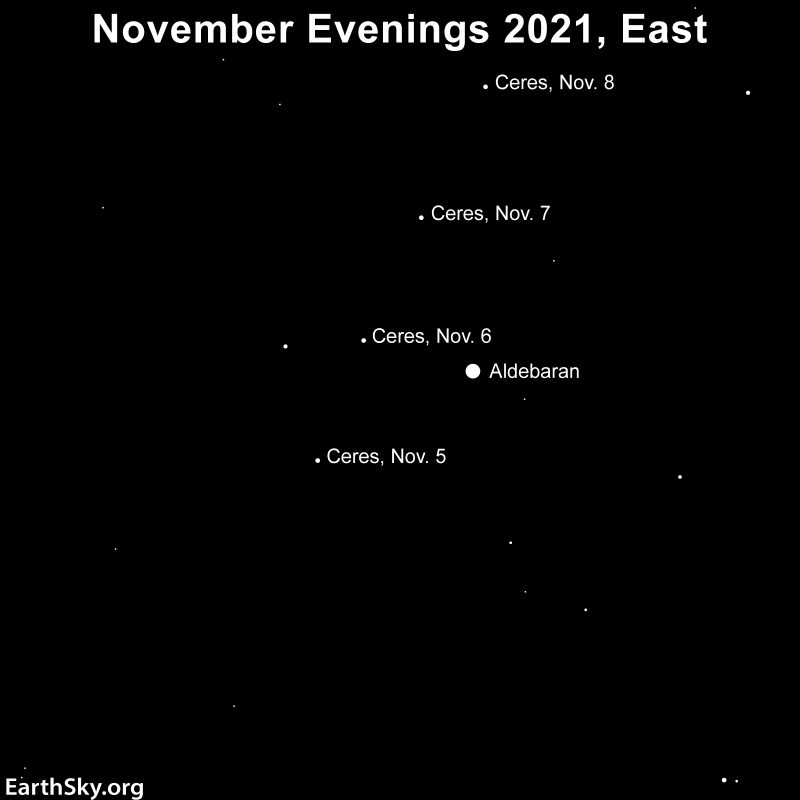Ceres was the first asteroid discovered in 1801, then reclassified as a dwarf planet in 2006. As the largest object in the asteroid belt, it was the only one with sufficient gravity to have a round shape. As a result, Ceres is now the only dwarf planet in the asteroid belt, or even within Neptune’s orbit, for that matter. With Ceres in opposition on November 27, or facing the sun in our sky, it will rise at sunset and set at sunrise. The dates around the opposition are the best times to see the dwarf planet, as it is the closest to Earth and the brightest. But a close encounter with one of the brightest stars in the sky provides additional viewing opportunities for Ceres in early November.
Ceres is about 600 miles (1,000 km) in diameter, or about 1/4 the size of our moon. With her size stuck somewhere between an asteroid and a planet, Ceres was a target of study for the Dawn mission.
How to see Ceres in opposition
Ceres is too dark to be seen without optical aid, so dust off your binoculars or telescope and head to a dark sky site. The brightness of astronomical objects is measured in something called magnitude, with lower numbers equivalent to brighter objects. From a location free from light pollution, you can see objects up to about magnitude 6. Ceres in opposition will be magnitude 7; therefore, you will need an optical aid to wrap this unique item.
On November 27, you can go out late in the evening when the sky has turned beautiful and dark, but before the almost half-lit moon rises after midnight. Use the table here to find Ceres residing next to the Hyades cluster, or the V-shaped cluster of stars in Taurus the Bull. In fact, Ceres spends all fall meandering through Taurus, cutting through the Hyades star cluster.

November 6/7 may not be an opposition or when Ceres is most brilliant, but it will be the date when Ceres is easiest to find. Ceres of magnitude 7.5 will be only 10 minutes of arc from the brilliant reddish orange star Aldebaran in Taurus. 10 minutes of arc is about 1/3 the size of a full moon, or 1/6 the width of your pinky finger held at arm’s length. Either way, if you focus binoculars or a telescope on Aldebaran, the point of light just northeast of the star will be Ceres.
Observe Ceres
Ceres is not easy to observe. Being distant and faint, it requires at least binoculars to spot it and even then it only appears as a bright spot like a distant star. Ceres does us a disservice in his reflection. Objects have a measure called albedo, which is a number between 0 and 1 indicating how black or white it is. Fresh snow or ice can have an albedo of 0.8 or 0.9. Venus, with its thick cloud cover, has an albedo of 0.65. Venus is bright because it reflects a lot of sunlight. On the other hand, low albedo objects absorb most of the sunlight and are quite dark. Charcoal and fresh asphalt both score 0.04 for their albedo. The albedo of Ceres is 0.07. He practically hides in the dark against the blackness of space.
Ceres may be the brightest dwarf planet, but only because it is in the asteroid belt, the debris zone of the solar system between Mars and Jupiter. Pluto’s albedo is 0.30 and Eris’s is 0.86, one of the highest albedo in the solar system. Ceres is only about 3 times farther from the sun than Earth. Compare that to Pluto, which is 40 times farther from the sun than Earth. And Eris is 68 times farther from the sun.
Ceres has a few shiny specks on its surface, which the Dawn spacecraft inspected in 2015.
The discoveries of dawn in Ceres
Dawn arrived in Ceres in 2015. Some of the discoveries made by Dawn in orbit around Ceres are the discovery of icy deposits in the crust of the dwarf planet, a 2.5 mile (4000 meter) high mountain named Ahuna Mons, and bright spots created by the salt water in Ceres’s Interior.

Conclusion: With Ceres in opposition on November 27, the dwarf planet is closest to Earth and therefore the brightest, making it an ideal time to observe it. Ceres will be by Aldebaran around November 6 and 7.
 Universo Viviente
Universo Viviente



